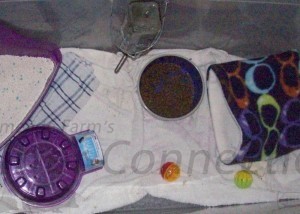Last Updated on February 5, 2024.
Natural Instinct
- Hedgehogs sleep during the day in any dark places that they can find.
- In the wild, they may hide from other animals in vacated burrows, under rocks, or in thick vegetation. They typically dig their own shallow burrows under some form of cover.
- They enter and exit their burrows headfirst, so burrows or hiding places must be large enough for them to turn around.

Cage Activity
- In captivity, hedgehogs enjoy burrowing in whatever they can find.
- Ideally, your hedgehog’s cage is large enough to provide an igloo or other object in which it can hide. This not only enriches your hedgie’s environment, it also makes it feel more secure.
- The Lixit igloo and a sleeping bag together provide a great place for a hedgehog to burrow in its cage.
Escaped Hedgehogs
- Immediate Surroundings:
When a pet hedgehog goes missing, it’s crucial to conduct a thorough search of the immediate surroundings. Begin by meticulously scouring the room or area where the hedgehog’s enclosure is located, paying close attention to potential hiding spots such as under furniture, in closets, or behind appliances. Hedgehogs are adept at finding inconspicuous nooks, so a meticulous search is essential.
- Under Furniture and Appliances:
Hedgehogs are known for their ability to squeeze into small spaces, and it’s not uncommon for them to seek refuge under furniture, refrigerators, stoves, and other household appliances. Take care to inspect these areas carefully, as a wandering hedgehog might choose them as temporary hiding places. - Dark and Quiet Areas:
Hedgehogs are nocturnal creatures and are naturally drawn to dark, quiet spaces. When searching for an escaped pet hedgehog, focus on areas where they may feel secure, such as under beds, within closets, or in dark corners of a room. - Nearby Hiding Spots:
If your home has access to outdoor spaces, be sure to check potential outdoor hiding spots near the point of escape. Hedgehogs may seek refuge under porches, decks, or in garden sheds, so a systematic inspection of these areas is advisable. - Utilize Food and Scent Trails:
Hedgehogs have a keen sense of smell, and utilizing food and scent trails can be an effective method for luring a wandering pet back to safety. Place the hedgehog’s favorite treats or a familiar scented item near the enclosure, creating a trail that may entice the hedgehog to return. - It’s important to remember that hedgehogs are sensitive animals, and the experience of an escape may cause them distress. As such, approaching the search with patience, gentleness, and a keen understanding of the hedgehog’s needs is essential for their well-being. The unexpected escape of a pet hedgehog can be a cause for concern, but with a systematic and considerate approach, the chances of a safe return are significantly heightened. By focusing your search on the aforementioned areas and employing thoughtful strategies, the safe recovery of a wandering hedgehog can be a rewarding and heartwarming experience for both the owner and the beloved pet.
Handling Challenges
- Many hedgehogs will try to burrow into their human friends to find warm, cozy places to sleep.
- Given the opportunity, most hedgehogs will root and wiggle their way into the crook of an arm or possibly your neck to find a warm place to sleep.
- Should your hedgehog find you a safe place to burrow and sleep, seize this as an excellent bonding opportunity!
- Some adventurous hedgehogs will try to crawl up sleeves, inside of shirts or even pant legs to explore, root around and maybe take a snooze.
Primary Author: Gail Smith, Millermeade Farm’s Critter Connection
Contributors: Melissa Ramos, MaryLynn McDermott, Coley Emde








